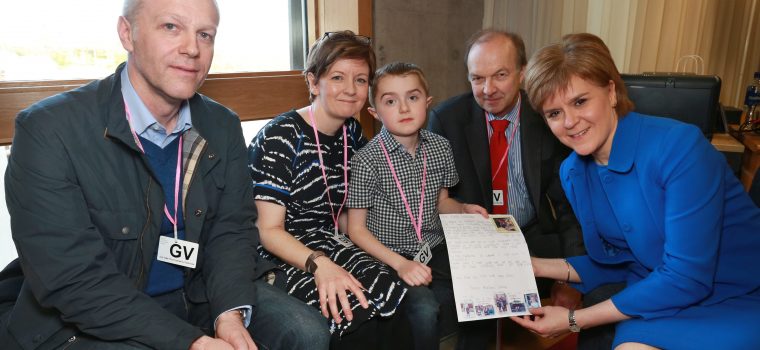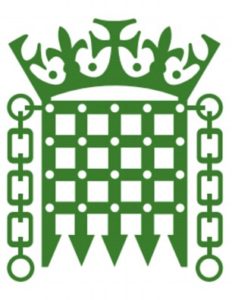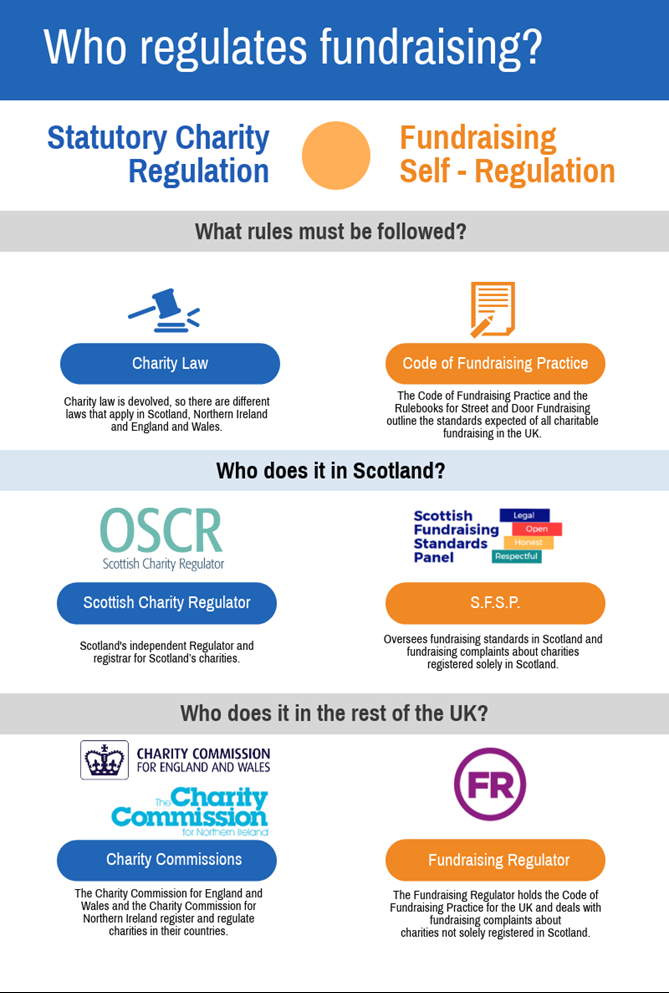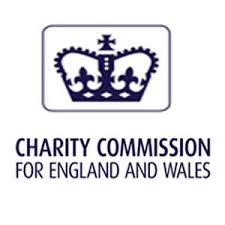Welcome to the overview of developments in rare disease research and our look at how charities work with other agencies to bring about public policy changes. We will consider charity governance and trustees and, in the blog, you will find views on a range of topics including electoral politics.

Robert meets Nicola Sturgeon in her office with the Young family, pressing for access to first genetic therapy to benefit Michael who has Duchenne muscular dystrophy (see article below).
Keep an eye on these pages for articles of interest, policy reviews and book extracts. These will mainly focus on developments in research, public policy and the charity sector. Developments in behavioural economics, elections and contemporary politics are also of great interest as we look at the post-Trump and post-Brexit era for any signs that good government is being restored in the UK. Corruption and fraud have no place in government, business and the conduct of elections. With the rule of law and individual rights, open and honest elections are at the heart of a modern democracy.
Robert's Blog: Latest Posts
The extraordinary period in office of Donald Trump, 45th President of the United States, is coming to its close in much the same way it started…
⇒ View here
SMA Groups Outraged Over UK Rejection of Spinraza Coverage as Too Expensive.
⇒ View here
Expert reaction to news that doctors at Newcastle Fertility Centre are first in UK granted permission to use mitochondrial replacement therapy.
⇒ View here
In 2015 the UK became the first country in the world to legalise mitochondrial donation, a controversial assisted reproductive technology.
⇒ View here
Snap election: What it means for UK charities. Take a look at issues that U.K. charities deem important for the next government.
⇒ View here
As the rest of Europe competes to rehome the European Medicines Agency (EMA) from London, minds at home are finally focusing on what that means for access to new treatments in a post-Brexit Britain.
⇒ View here
Rise in number of disabled people having to buy their own wheelchair.
⇒ View here
We are delighted to present this third edition of our Inclusive education for children with muscle-wasting conditions: a guide for schools and parents.
⇒ View here
NICE has published final guidance recommending ataluren for treating children aged 5 and over with Duchenne muscular dystrophy (DMD) caused by a nonsense mutation.
⇒ View here
John Walton had two overlapping careers, each in its way as distinguished and influential as the other. First, as Dr and later Professor Walton, he made his mark in clinical medicine and research, building a reputation in neurology and the study of muscular dystrophy.
⇒ View here
The Lord Palmer writes: For the last 15 years Lord Walton of Detchant (obituary, April 28) and I were nearly always on the same 1pm train from Kings Cross to Berwick-upon-Tweed.
⇒ View here
The day was hosted by Dr. Anthony Behin from the Centre de Reference de Pathologie Neuromusculaire in Paris and was also attended by Dr. Andoni Urtizberea from the Institute of Myology.
⇒ View here
I am delighted to have this opportunity to mark Professor Lord Walton’s outstanding personal contribution to Muscular Dystrophy UK or, as the charity was known when founded in 1959, the Muscular Dystrophy Group of Great Britain and Northern Ireland.
⇒ View here
David Cameron, the Prime Minster, said the new law would not lead to ‘designer babies’
⇒ View here
We are delighted that you are able to join us for the celebratory launch of our new centre. This represents the culmination of 50 years of excellence in muscular dystrophy research and care in Newcastle under a new identity.
⇒ View here
The full pros and cons of screening patients were too often poorly explained, skated over, or presented in a confusing manner, expert witnesses said during an evidence session of the House of Commons science and technology committee’s inquiry into national health …
⇒ View here
In 2009 the Human Fertilisation and Embryology Act was amended to allow mitochondrial donation, but a number of organisations opposed it. The technique is controversial because it combines nuclear DNA from both parents with a tiny amount of mitochondrial DNA from a …
⇒ View here
Blow The onset of dementia symptoms is often an additional blow to the families of a loved one with Parkinson’s disease. It is a significant problem for patients and their families, and can affect their ability to cope at home. It is often the development of dementia and other cognitive difficulties …
⇒ View here
It is almost 200 years since James Parkinson described the major symptoms of the disease that came to bear his name.
⇒ View here
Whenever a scientific finding could become important for the improvement of human health, the press will quickly herald it as a breakthrough. But similarly, when things take a sour turn, they are hastily reported as major calamities. The first full-scale clinical trial of fetal-tissue …
⇒ View here
The cells in question are human embryonic stem cells, up to 100 of which make up the embryo in its first few days after conception. Researchers want to see if they can persuade them to grow into replacement components for people whose original cells have failed: to replace nerve …
⇒ View here
Formal Articles & Statements
This paper is a response to Bovens and his suggestions that some challenges in the paper by Sanders et al (2018) can be ‘aptly illustrated’ by means of charity nudges intended to increase charitable donations…
⇒ View here
Public policy and medical research charities
We will look at the interface with government both in the UK and in the EU, noting as an example of the early impact of Brexit the decision of the EMA (European Medicines Agency) to relocate from London to Amsterdam.
This has placed the key regulatory body for approval of new drug treatments and interventions outside the UK sending a clear signal to industry that the UK is now in the second lane not on the fast track to access new treatments.
We will highlight two key developments in medical research where research charities played an important role with scientists, NHS consultants and ethicists to ensure the public debate was guided by evidence, data and the patients’ experience.
Christine Hamilton has been removed as a charity ambassador after comparing burkas to the hoods of the Ku Klux Klan.
⇒ View here
A boy with severe disabilities is suing the amusement park he describes as his “favourite place in the whole world” for not providing a toilet that he can use.
⇒ View here
SMA Groups Outraged Over UK Rejection of Spinraza Coverage as Too Expensive.
⇒ View here
Expert reaction to news that doctors at Newcastle Fertility Centre are first in UK granted permission to use mitochondrial replacement therapy.
⇒ View here
In 2015 the UK became the first country in the world to legalise mitochondrial donation, a controversial assisted reproductive technology.
⇒ View here
Snap election: What it means for UK charities. Take a look at issues that U.K. charities deem important for the next government.
⇒ View here
South West Neuromuscular News – Bringing together patients and professionals to improve healthcare outcomes in neuromuscular conditions.
⇒ View here
We are delighted to hear that over £28 million has been awarded to University College London (UCL) to boost research into neuromuscular conditions and other neurological conditions.
⇒ View here
As the rest of Europe competes to rehome the European Medicines Agency (EMA) from London, minds at home are finally focusing on what that means for access to new treatments in a post-Brexit Britain.
⇒ View here
Rise in number of disabled people having to buy their own wheelchair.
⇒ View here
Trustee Baroness Thomas in Top 10 of disability influence list.
⇒ View here
We are delighted to present this third edition of our Inclusive education for children with muscle-wasting conditions: a guide for schools and parents.
⇒ View here
NICE has published final guidance recommending ataluren for treating children aged 5 and over with Duchenne muscular dystrophy (DMD) caused by a nonsense mutation.
⇒ View here
John Walton had two overlapping careers, each in its way as distinguished and influential as the other. First, as Dr and later Professor Walton, he made his mark in clinical medicine and research, building a reputation in neurology and the study of muscular dystrophy.
⇒ View here
John Walton, Lord Walton of Detchant, who has died aged 93, was a neurologist who improved the diagnosis and treatment of muscular dystrophy.
⇒ View here
The Lord Palmer writes: For the last 15 years Lord Walton of Detchant (obituary, April 28) and I were nearly always on the same 1pm train from Kings Cross to Berwick-upon-Tweed.
⇒ View here
The day was hosted by Dr. Anthony Behin from the Centre de Reference de Pathologie Neuromusculaire in Paris and was also attended by Dr. Andoni Urtizberea from the Institute of Myology.
⇒ View here
I am delighted to have this opportunity to mark Professor Lord Walton’s outstanding personal contribution to Muscular Dystrophy UK or, as the charity was known when founded in 1959, the Muscular Dystrophy Group of Great Britain and Northern Ireland.
⇒ View here
David Cameron, the Prime Minster, said the new law would not lead to ‘designer babies’
⇒ View here
National Health Screening – Third Report of Session 2014-15.
⇒ View here
We are delighted that you are able to join us for the celebratory launch of our new centre. This represents the culmination of 50 years of excellence in muscular dystrophy research and care in Newcastle under a new identity.
⇒ View here
Tributes have flooded in to multi-award-winning actor and director Lord Richard Attenborough, who has died aged 90.
⇒ View here
The full pros and cons of screening patients were too often poorly explained, skated over, or presented in a confusing manner, expert witnesses said during an evidence session of the House of Commons science and technology committee’s inquiry into national health …
⇒ View here
In 2009 the Human Fertilisation and Embryology Act was amended to allow mitochondrial donation, but a number of organisations opposed it. The technique is controversial because it combines nuclear DNA from both parents with a tiny amount of mitochondrial DNA from a …
⇒ View here
The UK government will push ahead with plans to allow mitochondrial donation during in vitro fertilisation (IVF) where the child will be at risk of inheriting a serious mitochondrial disorder. The decision came after a public consultation 1 and a safety and efficacy …
⇒ View here
More than 140 000 critically ill patients are admitted to intensive care in England and Wales each year. Delayed weaning (>14 days) and continued dependence on mechanical ventilation occur in 2-5% of these people.
⇒ View here
Blow The onset of dementia symptoms is often an additional blow to the families of a loved one with Parkinson’s disease. It is a significant problem for patients and their families, and can affect their ability to cope at home. It is often the development of dementia and other cognitive difficulties …
⇒ View here
It is almost 200 years since James Parkinson described the major symptoms of the disease that came to bear his name.
⇒ View here
Family doctors should refer patients with suspected Parkinson’s disease promptly to a specialist rather than try and diagnose it themselves, recommends guidance on the diagnosis and management of the disease, published this week … The guidelines, which were developed by the National …
⇒ View here
Whenever a scientific finding could become important for the improvement of human health, the press will quickly herald it as a breakthrough. But similarly, when things take a sour turn, they are hastily reported as major calamities. The first full-scale clinical trial of fetal-tissue …
⇒ View here
The cells in question are human embryonic stem cells, up to 100 of which make up the embryo in its first few days after conception. Researchers want to see if they can persuade them to grow into replacement components for people whose original cells have failed: to replace nerve …
⇒ View here
Perhaps because it is so common among residents of nursing and care homes, many staff see symptoms of Parkinson’s disease as ‘just normal ageing’. However, in the first of a new series on drug treatments, Alun Morinan describes the difficulties faced by people with this …
⇒ View here
OVERVIEW OF THE CHARITY SECTOR (2019)
You can find information here regarding charities and their role as nonprofits (the term used more often in the US) in research, providing services and ensuring the needs of their beneficiaries are understood.
 Robert as Research and Policy Director at Parkinson’s UK (then the Parkinson’s Disease Society) and as CEO of Muscular Dystrophy UK worked to ensure patients had a voice and a platform in the media, in Parliament and with Ministers to explain in their own terms why changes in the law and the regulatory environment were desperately needed to develop new treatments.
Robert as Research and Policy Director at Parkinson’s UK (then the Parkinson’s Disease Society) and as CEO of Muscular Dystrophy UK worked to ensure patients had a voice and a platform in the media, in Parliament and with Ministers to explain in their own terms why changes in the law and the regulatory environment were desperately needed to develop new treatments.
Influencing aspects of the UK Life Sciences Strategy
Further, both the regulatory framework for research in genetics and the wider research environment in the UK are shaped at arm’s length by Ministers and politicians. They are expected to address conflicting arguments and pressures in developing the life sciences strategy. Nonprofits can play an important role in identifying strategic opportunities, working effectively in partnership across the public and private sectors in pursuit of common goals such as the regulation of clinical trials, faster access to new treatments and building clinical capacity in the NHS.
Overview of the Charity Sector
Terminology and clarity
The charity sector embraces organisations both large and small who between them provide services, support medical research and tackle emerging social issues. When the ‘third sector’ is discussed, the term is generally understood to include registered charities, housing associations and community organisations. Commentators and academics also use the term ‘civil society’ to refer to independent, non-governmental organisations. Unless otherwise stated, we intend to focus on the work of charities.
In England and Wales, there are currently more than 168,000 registered charities. Of these, around 2,000 are well known, large organisations which employ professional staff and look to influence public policy and priorities through lobbying activities.
Wide variations in the charity sector
Within this group, there are some 45 charities with an annual income of more than £100million who can promote their activities through television advertising, aggressive fundraising and skilled use of social media. In contrast, the overwhelming majority of charities are small local groups with an annual income below £100,000. They rely on volunteers rather than paid staff and many make an important contribution in their community.
Charity regulators
A summary of charity regulation and the role of the Fundraising Regulator is set out below. As recipients of funds from the public, all charities have legal, regulatory and ethical responsibilities to ensure effective management and governance controls are in place. Further, charities are accountable to donors and need to inform them how their donation has been used to support the charity’s work. This, in turn, helps to develop confidence in the effectiveness of the charity.








